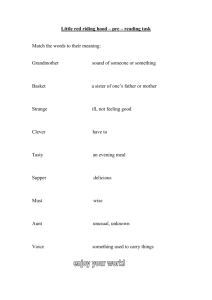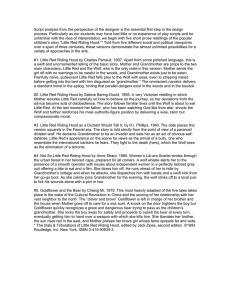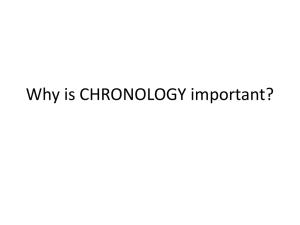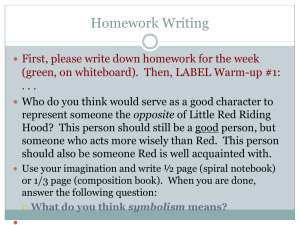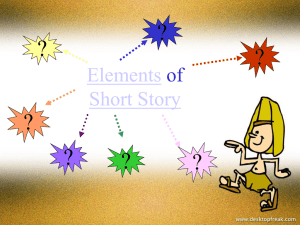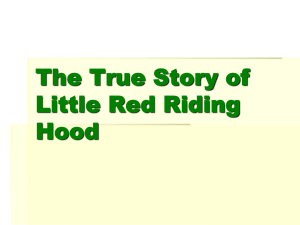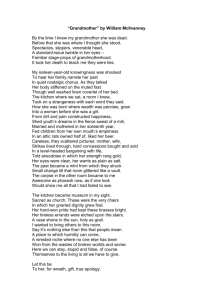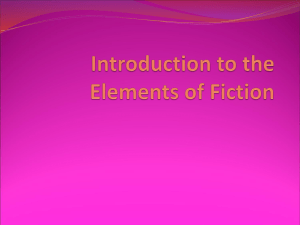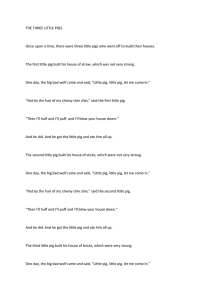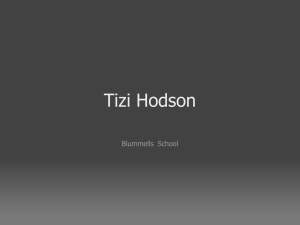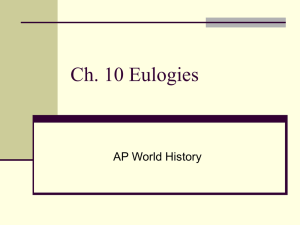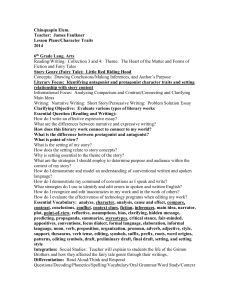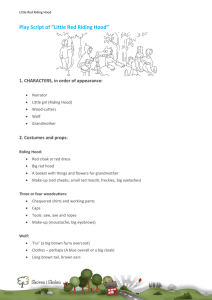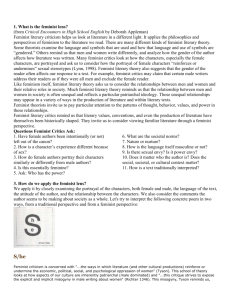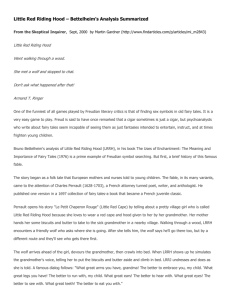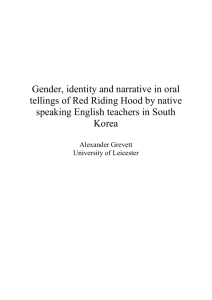ENG 4U2
advertisement
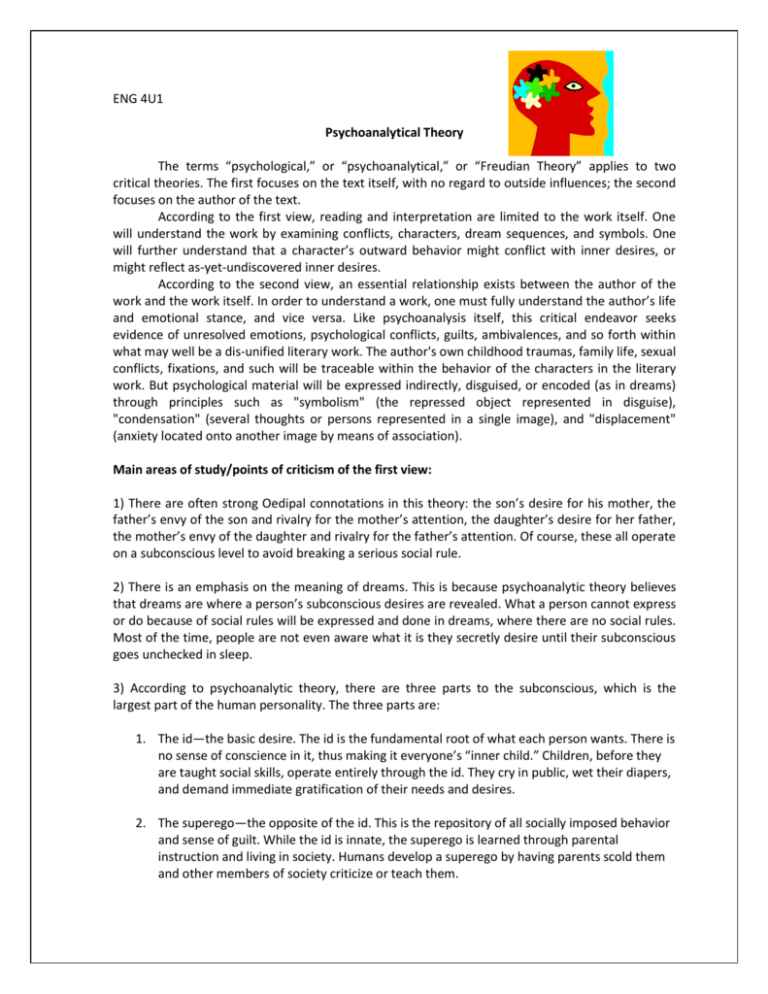
ENG 4U1 Psychoanalytical Theory The terms “psychological,” or “psychoanalytical,” or “Freudian Theory” applies to two critical theories. The first focuses on the text itself, with no regard to outside influences; the second focuses on the author of the text. According to the first view, reading and interpretation are limited to the work itself. One will understand the work by examining conflicts, characters, dream sequences, and symbols. One will further understand that a character’s outward behavior might conflict with inner desires, or might reflect as-yet-undiscovered inner desires. According to the second view, an essential relationship exists between the author of the work and the work itself. In order to understand a work, one must fully understand the author’s life and emotional stance, and vice versa. Like psychoanalysis itself, this critical endeavor seeks evidence of unresolved emotions, psychological conflicts, guilts, ambivalences, and so forth within what may well be a dis-unified literary work. The author's own childhood traumas, family life, sexual conflicts, fixations, and such will be traceable within the behavior of the characters in the literary work. But psychological material will be expressed indirectly, disguised, or encoded (as in dreams) through principles such as "symbolism" (the repressed object represented in disguise), "condensation" (several thoughts or persons represented in a single image), and "displacement" (anxiety located onto another image by means of association). Main areas of study/points of criticism of the first view: 1) There are often strong Oedipal connotations in this theory: the son’s desire for his mother, the father’s envy of the son and rivalry for the mother’s attention, the daughter’s desire for her father, the mother’s envy of the daughter and rivalry for the father’s attention. Of course, these all operate on a subconscious level to avoid breaking a serious social rule. 2) There is an emphasis on the meaning of dreams. This is because psychoanalytic theory believes that dreams are where a person’s subconscious desires are revealed. What a person cannot express or do because of social rules will be expressed and done in dreams, where there are no social rules. Most of the time, people are not even aware what it is they secretly desire until their subconscious goes unchecked in sleep. 3) According to psychoanalytic theory, there are three parts to the subconscious, which is the largest part of the human personality. The three parts are: 1. The id—the basic desire. The id is the fundamental root of what each person wants. There is no sense of conscience in it, thus making it everyone’s “inner child.” Children, before they are taught social skills, operate entirely through the id. They cry in public, wet their diapers, and demand immediate gratification of their needs and desires. 2. The superego—the opposite of the id. This is the repository of all socially imposed behavior and sense of guilt. While the id is innate, the superego is learned through parental instruction and living in society. Humans develop a superego by having parents scold them and other members of society criticize or teach them. 3. The ego—reality. The ego takes the desires of the id, filters them through the superego, and comes up with an action that satisfies both entities. The ego realizes that the id must be satisfied, but that there are certain socially acceptable ways to achieve satisfaction. Main areas of study/points of criticism of the second view: Though a work might not be blatantly autobiographical, psychoanalysts argue that there is always something of the author in the work, whether it is a character, character trait, theme, or motif. Often, authors will satirize people they dislike or will be overtly sympathetic to people they do like. This author bias often has an effect on the reader, which is exactly what the author wants. When reading, people are very vulnerable to the author’s chosen point of view (the only way they hear the story is through the author’s narrator). This aspect of the psychoanalytic view is a very subjective and controversial approach to literature, but the psychoanalysts of the world argue that it is a valid and important type of literary study. Essential questions for a psychoanalytic reading: 1. How does the character view him or herself? 2. What do you learn about the character from the way other characters relate to him or her? 3. What discrepancies exist between the author’s portrayal of the character and the reader’s inferences? 4. What types of images are used in conjunction with the character? What do they symbolize? 5. Do any characters have dreams or inner monologues? What is revealed about a character through dreams that would not otherwise be revealed? 6. Are there any inner conflicts within the character? How are these conflicts revealed? How are they dealt with? Are they ever resolved? How? 7. Do any characters perform uncharacteristic actions? If so, what? What could these actions mean? Little Red Riding Hood Charles Perrault Once upon a time there lived in a certain village a little country girl, the prettiest creature who was ever seen. Her mother was excessively fond of her; and her grandmother doted on her still more. This good woman had a little red riding hood made for her. It suited the girl so extremely well that everybody called her Little Red Riding Hood. One day her mother, having made some cakes, said to her, "Go, my dear, and see how your grandmother is doing, for I hear she has been very ill. Take her a cake, and this little pot of butter." Little Red Riding Hood set out immediately to go to her grandmother, who lived in another village. As she was going through the wood, she met with a wolf, who had a very great mind to eat her up, but he dared not, because of some woodcutters working nearby in the forest. He asked her where she was going. The poor child, who did not know that it was dangerous to stay and talk to a wolf, said to him, "I am going to see my grandmother and carry her a cake and a little pot of butter from my mother." "Does she live far off?" said the wolf "Oh I say," answered Little Red Riding Hood; "it is beyond that mill you see there, at the first house in the village." "Well," said the wolf, "and I'll go and see her too. I'll go this way and go you that, and we shall see who will be there first." The wolf ran as fast as he could, taking the shortest path, and the little girl took a roundabout way, entertaining herself by gathering nuts, running after butterflies, and gathering bouquets of little flowers. It was not long before the wolf arrived at the old woman's house. He knocked at the door: tap, tap. "Who's there?" "Your grandchild, Little Red Riding Hood," replied the wolf, counterfeiting her voice; "who has brought you a cake and a little pot of butter sent you by mother." The good grandmother, who was in bed, because she was somewhat ill, cried out, "Pull the bobbin, and the latch will go up." The wolf pulled the bobbin, and the door opened, and then he immediately fell upon the good woman and ate her up in a moment, for it been more than three days since he had eaten. He then shut the door and got into the grandmother's bed, expecting Little Red Riding Hood, who came some time afterwards and knocked at the door: tap, tap. "Who's there?" Little Red Riding Hood, hearing the big voice of the wolf, was at first afraid; but believing her grandmother had a cold and was hoarse, answered, "It is your grandchild Little Red Riding Hood, who has brought you a cake and a little pot of butter mother sends you." The wolf cried out to her, softening his voice as much as he could, "Pull the bobbin, and the latch will go up." Little Red Riding Hood pulled the bobbin, and the door opened. The wolf, seeing her come in, said to her, hiding himself under the bedclothes, "Put the cake and the little pot of butter upon the stool, and come get into bed with me." Little Red Riding Hood took off her clothes and got into bed. She was greatly amazed to see how her grandmother looked in her nightclothes, and said to her, "Grandmother, what big arms you have!" "All the better to hug you with, my dear." "Grandmother, what big legs you have!" "All the better to run with, my child." "Grandmother, what big ears you have!" "All the better to hear with, my child." "Grandmother, what big eyes you have!" "All the better to see with, my child." "Grandmother, what big teeth you have got!" "All the better to eat you up with." And, saying these words, this wicked wolf fell upon Little Red Riding Hood, and ate her all up.
